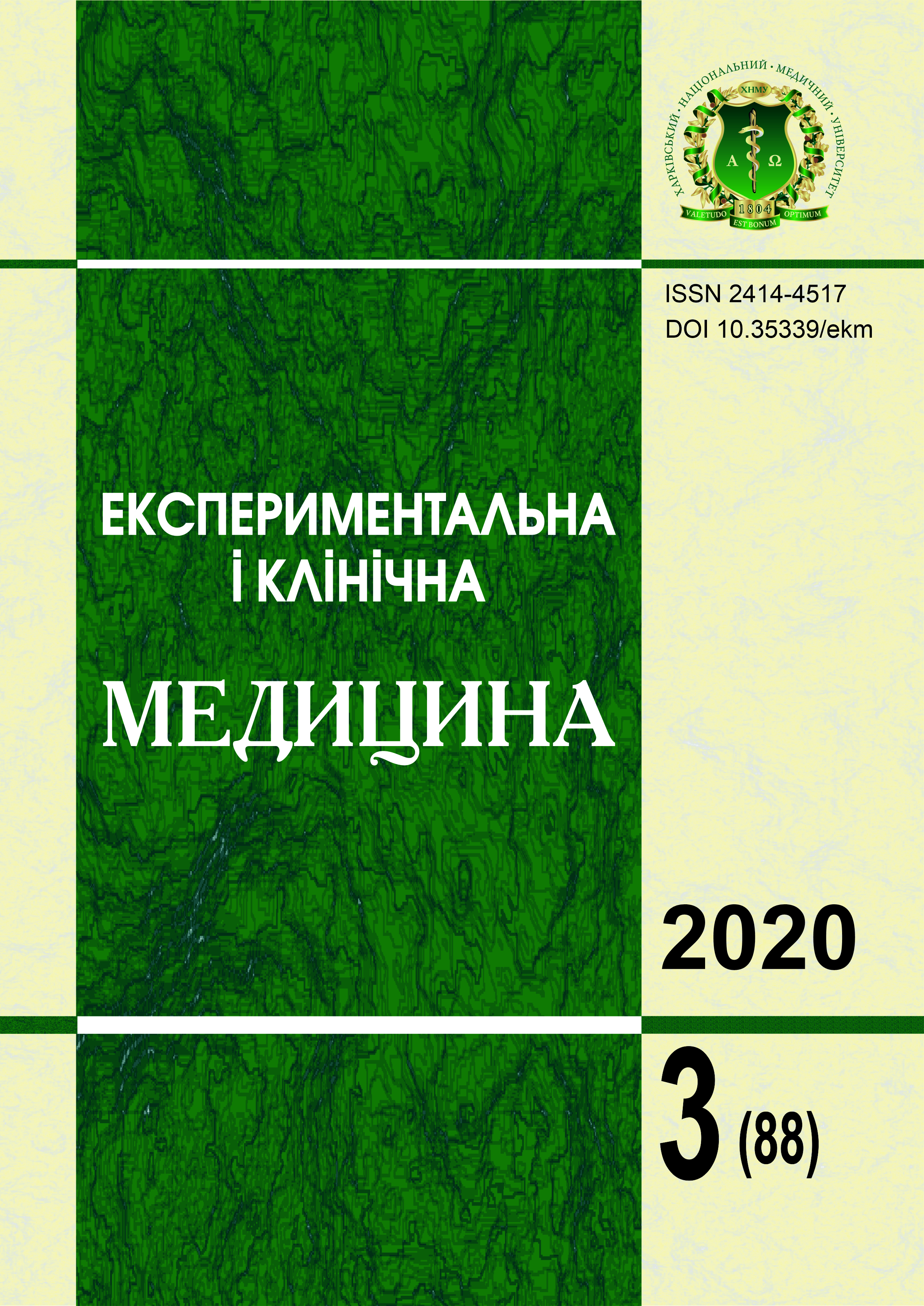Abstract
On the basis of the Military Medical Center of the Northern region (Kharkiv) a comprehensive examination of 75 combatants who were injured and had non-psychotic mental disorders was conducted. According to the results of the study, the clinical structure of non-psychotic mental disorders in the examined combatants who were injured was presented as depressed (32.2% of the examined), anxious (31.8%), dysphoric (9.5%), asthenic (15.6%). and psychosomatic (10.9%) variants of psychopathological symptoms. Risk factors for the development of non-psychotic mental disorders in the examined patients were: the fact of injury (66.5%), uncertainty of treatment prognosis (69.2%), prolonged stay in a combat situation (33.1% of subjects), insufficient level of special training before hostilities (33.1%), fear of being taken prisoner (32.5%), death and serious injuries of fellow human beings in front of their own eyes (61.6%); the need to participate in the evacuation of the bodies of the dead (70.1%), the threat of death under volley fire or from a sniper's shot (42.2%), prolonged stay in the field (dugouts, tents) (39.1%). According to the psychodiagnostic study on the scale of clinical diagnosis of PTSD (Clinical administered PTSD Scale-CAPS) in the examined combatants, the frequency of PTSD symptoms was (33.9±3.6) points, their intensity - (32.2±5.5) points, total severity of symptoms - (67.1±6.9) points, which corresponds to the state of clinically pronounced manifestations of PTSD. It was found that the examined patients have: severe depressive (55.6%) and anxiety (71.2%) episodes on the clinical scales of anxiety (HAM-A) and depression (HAM-D) Hamilton; clinical manifestations of anxiety (68.2%) and depression (72.5%) on the hospital scale of anxiety and depression (HADS).
Keywords: combatants, PTSD, nonpsychotic mental disorders, distress, trauma.
References
Aymedov K.V., Voloshchuk A.E.,Asyeyeva Yu.O., & Tolmachov O.A. (2016). Suchasnadiahnostychna kontseptsiya posttravmatychnoho stresovoho rozladu [Modem diagnostic concept of post-traumatic stress disorder], Arkhiv psykhiatriyi - Archive of Psychiatry, 22(2), pp. 128-129 [in Ukrainian].
Mamta N.A., & Zavorotnyi V.Y. (2018). Printsipy reabilitatsii voyennosluzhashchikh s razlichnymi variantami posttravmaticheskogo stressovogo rasstroystva [Principles of rehabilitation of servicemen with various variants of post-traumatic stress disorder], Ukrainskiy visnikpsikhonevrologii - Ukrainian Newsletter of Psychoneurology, 26(3(96)), pp. 33-38 [in russian].
Bohomolets O.V., Pinchuk I.Ya., & Ladyk-Bryzghalova A.K. (2016). Poshyrenist ta struktura posttravmatychnykh psykhichnykh pomshen v uchasnykiv boyovykh diy [Prevalence and structure of post-traumatic mental disorders in combatants], Arkhiv psykhiatriyi - Archives of Psychiatry, 22(2), pp. 11-15 [in Ukrainian].
Yuryeva L.N. (2017). Diagnostika, korrektsiya і profilaktika krizisnykh sostoyaniy u uchastnikov voyennykh konfliktov [Diagnostics, correction and prevention of crisis conditions among participants in military conflicts:]. Dnepr: Novaya ideologiya, 204 p. [in russian].
Semigina T., Pavlenko I.E., Ovsyannikova E., et al. (Trans.) (2017). Okhorona psykhichnoho zdorovya v umovakh viyny [Protection of mental health in conditions of war], (vols. 1–2; vol. 1). Kyiv: Nash format, 579 p. [in Ukrainian].
Karpov S.M., Bakhadova E.M., Apaguni A.E., & Kaloev A.D. (2014). Otdalennyye posledstviya minno-vzryvnogo raneniya, как faktor psikhonevrologiches kikh namsheniy [Long-term consequences of a mine-explosive wound as a factor of neuropsychiatric disorders], Vestnik novykh meditsinskikh tekhnologiy - Bulletin of new medical technologies, 21(3), pp. 100-103 [in russian].
Verba A.V., Barbazyuk O.A., Shvets A.V., et al. (2017). Vkazivky shchodo zberezhennya psykhichnoho zdorovya viys'kovosluzhbovtsiv v zoni zastosuvannya viys'k (syl) ta pid chas vidnovlennya boyezdatnosti viyskovykh chastyn (pidrozdiliv) [Guidelines for maintaining the mental health of servicemen in the area of application of troops (forces) and during the restoration of combat capability of military units]. О.V. Dmz, V.S. Hichun (Ed.). Kyiv, 102 p. [in Ukrainian].
Kozhyna H.M., Strelnikova I.M., Zelenska K.O., et al. (2019). Metod psykhosotsial'noyi reabilitatsiyi stanu viys'kovosluzhbovtsiv - uchasnykiv boyovykh diy z travmatychnymy ushkodzhennyamy mahistralnykh sudyn kintsivok, shcho uskladnylysya rozladamy adaptatsiyi [Method of psychosocial rehabilitation of servicemen - participants of hostilities with traumatic injuries of the main vessels of the extremities, complicated by adaptation disorders], Informatsiynyy lystpro novowedennya v systemi okhorony zdorovya 178-2019 - Information letter about innovations in the health care system 178-2019, Kiev, 4 p. [in Ukrainian].
Voloshyn P.V., Mamta N.O., Shestopalova L.F., et al. (Compiler). (2014). Diahnostyka, terapiya ta profilaktyka medyko-psykholohichnykh naslidkiv boyovykh diy v suchasnykh umovakh (metodychni rekomendatsiyi) [Diagnosis, therapy and prevention of medical and psychological consequences of hostilities in modem conditions (guidelines)]. Kharkiv, 79 p. [in Ukrainian].
Zavorotnyy V.I. (2018). Diagnosticheskiye prediktory і kriterii razlichnykh variantov post-travmaticheskogo stressovogo rasstroystva u voyennosluzhashchikh Vooruzhennykh Sil Ukrainy, uchastvovavshikh v boyevykh deystviyakh na Vostoke Ukrainy [Diagnostic predictors and criteria of various variants of post-traumatic stress disorder in the military personnel of the Armed Forces of Ukraine who participated in hostilities in the East of Ukraine], Ukrainskiy visnik psikhonevrologii - Ukrainian Bulletin of Psychoneurology, 26(2(95)), pp. 43-47 [in russian].
Dmz О.V, & Chernenko I.O. (2017). Napryamky medyko-psykholohichnoyi profilaktyky post- stresovykh psykhichnykh rozladiv u uchasnykiv lokal'nykh boyovykh diy [Directions of medical and psychological prevention of post-stress mental disorders in participants of local hostilities], Ukrayinskyy visnyk psykhonevrolohiyi - Ukrainian Bulletin of Psychoneurology, 25(1(90)), pp. 45-48 [in Ukrainian].
Maruta N.O., & Markova M.V. (2015). Informatsiyno-psykholohichna viyna yak novyy vyklyk suchasnosti: stan problemy ta napryamky yiyi podolannya [Information-psychological war as a new challenge of modernity: the state of the problem and directions of its overcoming]. Ukrayinskyy visnyk psykhonevrolohiyi - Ukrainian Herald of Psychoneurology, 23(3(84)), pp. 21-28 [in Ukrainian].
Voloshyn P.V., & Maruta N.O. (Eds.). (2016). Sotsialno-stresovi rozlady (klinika, diahnostyka, profilaktyka) [Socio-stress disorders (clinic, diagnosis, prevention)]. Kharkiv: Vydavets Strokov D.V. 335 p. [in russian].

